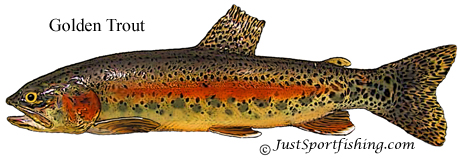|
Home Game Fish Fishing Knots Tackle Tips Videos Pictures Tips Rods & Reels Boats Cook your Catch Articles About Contact |
|
Donate to JustSportfishing.com and help to build the largest fishing information site on the web. Even a dollar or two will keep us building this free site.
|
Golden
Trout World
Record
~ 11 Lbs. Caught at Cooks Lake, WY on Aug. 5, 1948 by angler Charles S.
Reed Scientific
name
~ Oncorhynchus Aguabonita Other names ~ Kern River Golden Trout, Mountain Trout, California Golden Trout
Identification
~ The Golden Trout has an olive-green back and bright red-to-gold sides
and belly. In the spring spawning season, the colors are extremely
intense. It is the most colorful of the trout species. Golden trout are
native only to a few small lakes and streams at high elevations in the
Sierra Nevada of California. The California golden trout is native only
to two high-altitude watersheds in California's rugged Sierra Nevada
Mountains. Its native range once encompassed an estimated 450 miles of
stream habitat in the upper South Fork Kern River and adjacent Golden
Trout Creek. Preferred water temperature is 58-62 °F. They were
introduced into other lakes and streams outside the Sierra Nevada
including the mountain lakes of southern Alberta and into New Mexico.
Golden trout are very specialized for their particular environment, and
do not do well in lower-elevation streams and lakes. The short growing
season of the high mountain lakes does not allow this trout to grow
fast, and so most Golden Trout are small. However, they are highly
prized by the adventurous angler. Size
~ The Golden trout grows slowly due to the short growing season of the
high altitude lakes and streams it inhabits. The Golden Trout can live
for 7 years and in its native streams rarely exceeds a pound. Habitat
~ The Golden Trout inhabits cool clear water high elevation (above 6,800
feet) lakes and streams. Native to California but have been introduced
in Alberta, Washington, Idaho, Wyoming, and New Mexico. Feeding
Habits
~ Golden Trout feed primarily on insects and insect larvae especially
Midges and Caddisflies.
|


